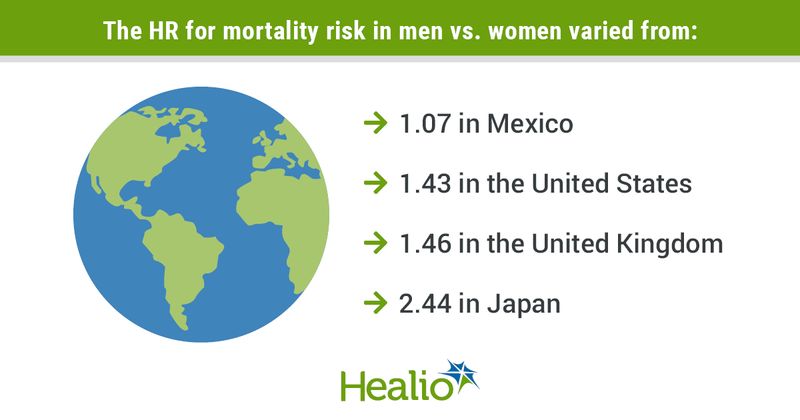Men have 60% higher risk for death, worldwide study shows
Click Here to Manage Email Alerts
Men aged 50 years or older had a 60% higher mortality risk than women aged 50 years or older, in part due to smoking and CVD rates, a worldwide study published in the Canadian Medical Association Journal showed.
“Many studies have examined the potential impact of social, behavioral and biological factors on sex differences in mortality, but few have been able to investigate potential variation across countries,” Yu-Tzu Wu, PhD, a research associate at King’s College London, and colleagues wrote.

In general, women have longer life expectancies but higher rates of disability and morbidity than men, according to the researchers.
“Few studies have identified factors that explain higher mortality in men,” they wrote.
To help fill this research gap, Wu and colleagues analyzed data from 179,044 adults who were enrolled in 12 cohorts within the Ageing Trajectories of Health: Longitudinal Opportunities and Synergies (ATHLOS) project. The cohorts are from 28 countries, including the United States and countries in South America, Europe, Asia and Australia. Most cohorts in ATHLOS were established after 2000. The median age of the adults in the study was 63 years, nearly 55% were women and 14.7% died by the end of study follow-up (median follow-up period, 4 years).

Wu and colleagues reported that men had a 60% higher mortality risk than women (HR = 1.6; 95% CI, 1.51-1.7). They also noted that heterogeneity across all the studied countries varied greatly. For example, the HR ranged from:
- 1.07 (95% CI, 0.81-1.4) in Mexico;
- 1.43 (95% CI, 1.38-2.48) in the U.S.;
- 1.46 (95% CI, 1.35-1.57) in the United Kingdom; and
- 2.44 (95% CI, 1.54-3.85) in Japan.
The researchers also reported that among all participants, more than 40% refrained from drinking alcohol, 36.3% had a primary education or less and 20.7% were current smokers. Of four diseases that the researchers studied — CVD, diabetes, hypertension and depression —hypertension (40.4%) was most common, while diabetes (12.7%) was least common. Overall, 17.5% adults lived alone and 28.3% did not have a spouse.
“The strength of association between sex and mortality did not decrease when we adjusted for most socioeconomic, lifestyle, social or health factors,” Wu and colleagues wrote. “Sex differences in mortality became wider when we accounted for education, wealth, alcohol consumption, depression and no spouse.”
The researchers found that CVD (HR = 1.56; 95% CI, 1.46-1.66) and smoking (HR = 1.47; 95% CI, 1.39-1.55) were the only factors that “slightly attenuated” sex differences in mortality, prompting them to stratify age-adjusted HRs by smoking and smoking and CVD. This lowered the overall sex differences in nonsmokers (HR = 1.4; 95% CI 1.32-1.49) and former smokers (HR = 1.43; 95% CI, 1.32-1.56). The adjustment for smoking and CVD “further attenuated” the data (HR = 1.44; 95% CI, 1.36-1.52). The HR for overall sex difference dropped to 1.34 (95% CI, 1.25-1.44) in nonsmokers who did not have CVD.
“Our study highlights sex differences in mortality at older age and the crucial contributions of smoking to excess mortality in men,” Wu told Healio Primary Care. “The heterogeneity of sex differences in mortality across countries may indicate the potential impact of cultural and societal factors on healthy aging in addition to biological sex.”
